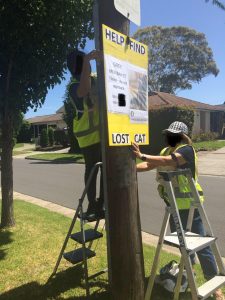You’ll often see ‘lost animal’ A4 sheets on lamp posts as you drive by. How much information on the flier can you read as you whizz past? Probably not much; perhaps just ‘lost’.
Do you drive back to read it? You’d be a rare person if you do.
To get people’s attention, you need to use much larger, much more eye-catching signs.
When to use ‘big signs’

Lost cat, Shi, was located soon after these big signs were erected. She had been missing for ten weeks
‘Big signs’ can be useful in generating sightings, especially if you feel your cat has gone further afield.
They are more effective for confident cats who tend to explore and be more visible to people. However, we have found many timid cats, like Shi, thanks to them.
If you’ve started to run out of steam and need a break from searching, they may help – at least to keep your lost cat in people’s minds.
Why big signs work
The key to the ‘big signs’ is to use minimal words and a clear photo, so that people can read all of the information on the sign while driving, without slowing down.
The Missing Animal Response Network describes it as 5+5+55 – people need to be able to read 5 words in 5 seconds while doing 55 miles per hour.
What you’ll need
- Fluoro 600mm x 900mm coreflute, preferably 5mm thick, but 3mm will do if that’s all you can find. In 2024, some Mitre 10 stores sell white coreflute and some Bunnings stores sell yellow coreflute. We use yellow coreflute from BiWize Signage Supplies in Thomastown. If you can only find white coreflute, buy some fluoro card from a stationery store and tape it to the coreflute.
- ‘PLEASE HELP’ and ‘LOST CAT’ printed in large letters on white paper then either laminated or taped with clear packing tape to the coreflute. If you have no funds for printing, you could use black paint or texta
- Laminated A3 sheets with basic information about your cat, or A4 sheets and sheet protectors. If possible, use matt, not gloss, so light doesn’t reflect
- Step ladder
- Cordless drill and drill bit
- Screwdriver
- Button-head screws (nails will rip the coreflute if windy)
- Packing tape
- Ideally, someone to hold the ladder
How to make them
- Buy 600 x 900mm sheets of yellow or fluoro coreflute, preferably 5mm thick. 3mm will be OK if it’s your only choice. In our experience, fluoro green coreflute doesn’t stand out well
- If you can’t find a bright colour, buy fluoro cardboard from a stationery store and tape it to white coreflute. Sign writers and some hardware stores sell white coreflute.
- On a Laserjet printer, print then laminate white sheets with ‘PLEASE HELP’ and ‘LOST CAT’, using the largest letters possible. Tape ‘PLEASE HELP’ at the top and ‘LOST CAT’ at the bottom of the sign.
- Print out two A3 (best) or A4 sheets:
- Left hand sheet: Good photo of your cat, cropped tightly, with minimal clutter in the background.
Use a blur tool to blur it out so your cat stands out more. - Right hand sheet: Brief description of cat, street and contact numbers
- eg ‘Fluffy black, Cnr Brown/Green St, 0411 222 333, 0422 333 444
- You don’t need to add your suburb, unless you’re at the border between two
- Laminate (preferable) each sheet. If using sheet protectors, place with opening at the bottom. Seal closed with sticky tape. Over time, sheet protectors can gather condensation, making it hard for people to see the image. Laminating is much better
- Stick the sheets onto the coreflute using packing tape.
Where to put the signs
Place the signs so that anyone entering your lost cat’s ‘catchment’ area will see the sign as they drive past. For a timid cat, try a 300m radius from your home, though they will usually be found much closer. For a confident cat, increase this to say 500m or 600m radius.
If your cat has been lost for a while, they may have travelled further. Increase the coverage of your signs.
How to fix signs to poles
Unless your signs are out of reach of pedestrians, mischievous people may remove them.
We recommend using a step ladder or full sized ladder to place them out of reach of people.
- Drill a hole into the lamp post at the centre top and bottom of the sign with a cordless drill
- Screw 25mm long button screws into the lamp post with a screwdriver. Button screws have a larger, flat ‘head’ on them, compared to a nail, and are less likely to tear the coreflute if it’s windy.
- Wrap packing tape around the sign and pole, to give extra strength. The Missing Animal Response Network recommends this method for taping them to poles.
*The Missing Animal Response Network recommends using ‘PLEASE HELP!’ or ‘HELP FIND!’ and NOT ‘REWARD’, as it engages the altruistic part of people’s brains more than ‘reward’ does. It also reduces the likelihood of:
– your cat being chased, potentially into traffic or away from where you knew they were
– you being contacted by scammers and crank calls.
How to fix signs to trees
If there are no suitable lamp posts in the area, wrapping packing tape around trees is another option.
Please don’t drill or nail into trees. This can damage them.
Instead, wrap packing tape around the sign and tree. The Missing Animal Response Network recommends this method.
More details and demo videos
The Missing Animal Response Network has more details on how to make these.
A YouTube video explains this further. A second video demonstrates how to fix them to lamp posts so they stay up.
Found them?

Once Ginny was found, volunteer Lauretta and her son updated the signs, to let the community know she’d been found
Make sure you update them to let everyone know you’ve found your cat. Many in your community will be pleased to know they’re back home. It also ensures that more people realise that lost cats are often found, if the right methods are used, like those detailed on this website.





